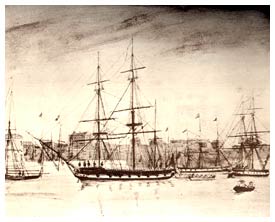According to yesterday’s Observer the HMS Beagle, the ship on which Charles Darwin sailed to the Galapagos Islands and around the world (and which later visited northern Australia, which ultimately led to Australia’s northernmost city being named after one of the greatest of all scientists) has been possibly located at the bottom of a marsh in Essex. There are no records as to where the ship was taken after being sold for scrap in 1870, but some historical detective work by Robert Prescott, a marine archaeologist from St Andrews University, followed by a radar survey appears to have tracked it down.
Given that this is the vessel onboard which one of the greatest of all scientific revolutions began, it would be wonderful if this ship could be raised out of the marsh and put in a museum somewhere, or perhaps it could be turned into a museum. Thematically it would be perfect in the Science Museum in Kensington, but I suspect that the 90 ft brig would be a little big for the building. And while it would presumably be possible to transport it up the Thames on some other vessel, transporting it through Chelsea to Kensington might be a little bit of a nuisance. So perhaps the Maritime Museum in Greenwich would be a better bet.

(Link via slashdot).




Simply getting the remains out of the marsh might be a job and a half.
Marshes have that 1/2 liquid 1/2 solid quality that makes it ever so unpleasant to either float, or drive the sort of equipment that makes jobs like that easier close to the site.
Fred
I’m appalled.
Here in the U.S. we have historical ships of much older vintage than the Beagle kept in excellent condition and open to the public. Just check out the website for the U.S.S. Constitution, or, if you’re ever in Boston, the actual ship itself.
My family has a model of Old Ironsides that was built off the original plans the better part of a century ago. When I was a kid, it was a treat to be allowed to dust it (The things you can convince a kid to do with pleasure!)
I agree, they need to do what they can to ressurect the Beagle. It’s very cool to be allowed to see pieces of history like that.
You mean like HMS Victory?
There are historic ships from all over the world that have not been preserved for various reasons. Beagle was sold for scrap 40+ years after Darwin’s voyage. Remember that The Origin of the Species was not published until many years after the voyage, and was somewhat controversial to boot.
As an Essex girl, I’d rather like to keep it in Essex, if indeed it proves to be HMS Beagle. It will go nicely with the Saxon king’s burial chamber recently found in my town (Southend; the site is less than a ten-minute walk from my house!), and who knows what other historical treasures that may be found here. Perhaps Essex’s tawdry image could be turned around with the help of interesting and valuable finds such as these – maybe we could open up a new museum somewhere in the middle of the county.
I would be highly surprised if there is anything more than portions of the keel and a few feet above it, ballast stone and assorted fittings. Unless conditions are really good, wooden ships do not tend to look very good after a century under water.
The exception is of course ships sunk in very cold water (Vasa, some in the Great Lakes) or buried in bogs (some Viking long boats).
But anything recovered from such an historic vessel will be worth the effort.